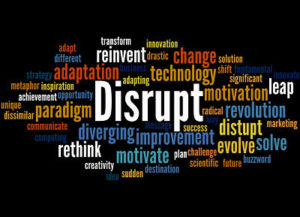|
|
 Marketing is always ripe with buzzwords that may or may not have any traction. Part of our role as marketing professionals and business leaders is to recognize when it’s hype and when it’s important. One of the words/trends that seems to be the new darling is the idea of disruption. This is one we can’t afford to dismiss as hype. It’s a huge opportunity and a huge threat.
Marketing is always ripe with buzzwords that may or may not have any traction. Part of our role as marketing professionals and business leaders is to recognize when it’s hype and when it’s important. One of the words/trends that seems to be the new darling is the idea of disruption. This is one we can’t afford to dismiss as hype. It’s a huge opportunity and a huge threat.
Many people misunderstand the term. Disruptive does not mean that your marketing tactics disrupt or interrupt your audience. Instead, what it actually means is that a new technology or product is going to disrupt an existing market or industry and actually create a new market or value proposition. Often this leads to the extinction of the original product or service by replacing it with something better. It’s the ultimate in creativity and destruction, all in one.
A great example is the point and shoot camera. The smart phone crushed the demand for inexpensive cameras and today; it’s tough to even find one in a store. The camera function wasn’t the primary focus of the smart phone, it was simply a feature. But that feature, coupled with technologies that actually made it superior to the original, ended up being a product killer.
Disruption isn’t about making a better mousetrap. It’s about making the mousetrap obsolete. Just ask Blockbuster or Kodak. They’re a great example of incredibly successful and profitable businesses that are now obsolete.
Disruption is fine and dandy, if you’re the one doing the disrupting, but how do you know if a new trend or technology has you in it’s sights?
Keep your perspective broad: Odds are, the disruption won’t come from within your own industry. It’s likely a technology that’s developing in a completely different field. It’s probably an innovation within it’s own category but runs the risk of being a game changer in yours.
Listen to your best users: It’s always a good plan to listen to your customers but if you’re worried about disruption – you need to step it up to a whole different level. Watch for an erosion of their usage or loyalty. Listen to their requests for product enhancements or add-ons.
Track trends: Disruptors don’t appear out of the blue. Typically they’re born from a broader trend or cultural shift. Watch for emerging trends, especially those that impact your super users/customers. If the trend is going to alter their lives, it could well alter yours too.
Explore and innovate: The best way to avoid becoming a disruptor’s victim is to keep evolving. You have to keep experimenting and exploring new ideas for the needs your customers have today and the ones they don’t even know they’re going to have tomorrow.
Measure and monitor: Part of surviving a disruptor may mean knowing when it’s time to pivot because you’re fighting a losing battle. You can’t afford to be caught off guard so now is not the time to get lax with your key performance indicators.
It’s important that we all recognize that we won’t escape disruption forever. It isn’t new and the world has always evolved over time. Think about the impact of the first cars, TV sets, and the personal computer and what they did to carriages, radio and typewriters. Disruption has always been around. It’s just that it’s coming at a pace we’ve never seen before. Technology is accelerating the disruption and that’s not likely to stop.
Your industry might have dodged it so far, but odds are – change is coming. You can brace yourself for the impact, you can see it on the horizon but most of all – you need to be thinking like a disruptor.
How can you evolve your offerings before someone makes you obsolete?
